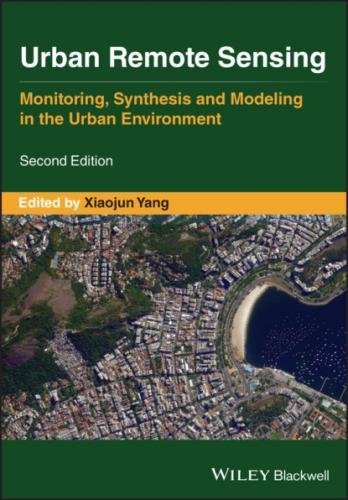2.4 RADIO DETECTION AND RANGING (RADAR) APPROACHES
2.4.1 BACKGROUND
With the capability to make Earth observations regardless of cloud cover and solar lighting conditions, radars have been successfully applied to Earth science studies and practical applications. Fundamentally, radar backscatter signatures are contributed by surface scattering such as from bare soil and bare ice, by a combination of surface and volume scattering such as from land surface with sparse and low vegetation cover, and by volume scattering such as from dense tropical forests (Ulaby et al. 1986; Tsang et al. 1985, and references therein). Specific to urban remote sensing, satellite radar data have been used to detect and observe urban characteristics in several cities (Henderson and Xia 1998; Dell'Acqua and Gamba 2006; Esch et al. 2009, 2017). Moreover, radars can delineate not only urban lateral extent in 2D but also building volume density in 3D (Nghiem et al. 2009; Mathews et al. 2019). The following subsections review the radar methodology applied to urban science research and applications.
2.4.2 DATA PROCESSING AND ANALYSIS
2.4.2.1 QuikSCAT SeaWinds Scatterometer
The SeaWinds scatterometer aboard the QuikSCAT satellite (JPL 2006) was launched in June 1999 from the Space Launch Complex 4 (SLC‐4) at the Vandenberg Airforce Base in California, the United States. By definition, a scatterometer is a stable and accurate radar that can measure radar backscatter representing the ratio of the radar signal returned from a target on the Earth over the transmitted signal, expressed in decibels (dB). The QuikSCAT SeaWinds scatterometer had a swath width of 1400 km for the horizontal polarization and 1800 km for the vertical polarization with a nearly daily global coverage of the Earth. Radar backscatter data at each polarization were acquired in antenna conical scans in the full 360° azimuth with a constant incidence angle. QuikSCAT collected data at a Ku‐Band frequency of 13.4 GHz over both land and ocean for more than a decade from 1999 to 2009. With frequent temporal observations, QuikSCAT has a low spatial resolution due to the antenna large footprint in an “egg” shape of 25 km in azimuth and 37 km in range, which is too large for urban remote sensing. Thus, a method was developed to use multiple data collections over a longer period to obtain radar observations at a 1 km grid that is applicable to urban scales. This approach, the Dense Sampling Method (DSM), is summarized in the next subsection to explain how the temporal resolution is traded off for urban monitoring throughout the decade of the 2000s.
2.4.2.1.1 Dense Sampling Method (DSM) for Built‐up Volume Analysis in Nine United States Cities
We provide a summary of the DSM but direct readers to the published literature for more mathematical and algorithmic details (Nghiem et al. 2009). First, QuikSCAT egg data are processed by a fast Fourier transform accounting for the Doppler compensation to generate a sub‐footprint thin “slice” data with a
(2.3)
where N is the total number of slice data centered at the given location, and
Notably, recent works have validated the capability of QuikSCAT data processed using the DSM for built‐up volume estimation in urban areas (Nghiem et al. 2017; Mathews et al. 2019). As an example, high DSM backscatter values for the Los Angeles area (see Figure 2.8a) exhibit a similar spatial pattern with high amounts of urban built‐up volume (Figure 2.8b shown with individual building extents – i.e. clipped by building footprints). Similarly, the building volume and DSM patterns across large areas such as Austin, Texas (Figure 2.9) are nearly indistinguishable, demonstrating the capability of DSM to capture 3D building volume structures in the city (Nghiem et al. 2017).
FIGURE 2.8 Pattern of DSM backscatter for greater Los Angeles, California (a) with stronger backscatter response in areas with higher amounts of urban built‐up volume (red; see downtown) and a transition to orange/yellow for suburban and rural area. In the downtown area (b), greater building footprint volumes (white) are spatially collocated with higher backscatter values (dark orange, red).
To quantitatively evaluate the degree to which DSM data can account for urban built‐up volume, we compared DSM backscatter to lidar‐derived building volumes aggregated to the same scale (1 km grid). Specifically, QuikSCAT data were processed using the DSM to match the geographic extent of airborne lidar data for nine cities in the United States (see Table 2.1 for extents): Atlanta, Austin, Buffalo, Detroit, Los Angeles, New Orleans, San Antonio, Tulsa, and Washington, DC. The DSM data collapsed one year's worth of observations into a single dataset gridded in a pixel size of ~1 km. The year of data matched the year of lidar data collection (Table 2.1); the lidar data were captured on differing dates but all during leaf‐on conditions during the summer months.
FIGURE 2.9 Spatial trend patterns for Austin, Texas in 2006 overlaid on Google Earth basemap. (a) The pattern of lidar‐derived building volume with the rainbow color
